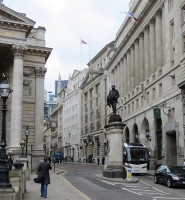
From Bank, facing the great portico of the Royal Exchange and Chantrey's equestrian statue of Wellington, Cornhill runs due east along the south side of that building, while angling slightly north of east and past the other side runs Threadneedle Street. Running from Bank south of east is Lombard Street, which itself splits after a few paces at St Mary Woolnoth, with Lombard Street continuing easterly and a little south, and King William Street going due South East.
Proceeding along Cornhill then, cutting north along Finch Lane would take us to Threadneedle Street, while southwards along Birchin Lane would lead to Lombard Street. Cornhill is quite short, and at its east end is a crossing, which is Bishopsgate running north, Gracechurch Street south and angling west, and the eastward continuation of Cornhill being Leadenhall Street. A brief amble down Cornhill gives opportunity to see a variety of modest Victorian and later architectural sculpture on some typical City buildings, a couple of free-standing statues, and the exteriors of two Wren churches.
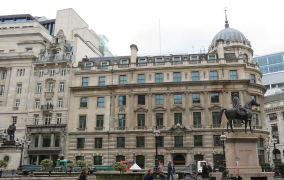 Bank end of Cornhill, with Wellington and Greathill statues, and nos. 1 and 14 Cornhill.
Bank end of Cornhill, with Wellington and Greathill statues, and nos. 1 and 14 Cornhill.
The building on the corner of Cornhill with Lombard Street is No 1 Cornhill, an impressive Portland stone creation, with five storeys and a dormer, and a corner dome with an extra storey. The building is decorated with minor carved ornament - festoons, wreaths, pots high up, and a couple of sheep s heads, but more interestingly, the entrance on Cornhill itself, the fourth bay along, has above it at second floor level a broken, open pediment with sculpture - a pair of female figures, seated on the side of a boat, whose prow sticks forward between them, holding aloft between them a globe, and in their other hands shields showing the cross of St George and some bird, a heron perhaps, with a leafy branch in its beak. Both wear crowns and are lightly draped. To the left as we look at the group, a figure of Neptune lurks, while to the right, a dragon is partly seen - altogether rather a busy composition. There is space at the bottom for the mottos 'Deus nobis haec otia fecit', and 'Domine dirige nos' - or 'God has made these times of leisure', and 'Lord guide us', the first of which is from Virgil, but is claimed as a motto by the Corporation of Liverpool, which would make the bird on the shield a Liver bird, and thus the premises those of some Liverpool bank or insurance company and it is no surprise to find this was the London office of the former Liverpool and London and Globe Insurance, dating from 1905, and by the architect MacVicar Anderson, Pevsner tells us. This instantly makes sense of the globe, and on the left is Liverpool, and that on the right, London, hence the dragon. Nice work, but I did not spot any signature of the sculptor.
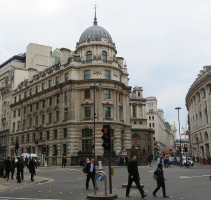
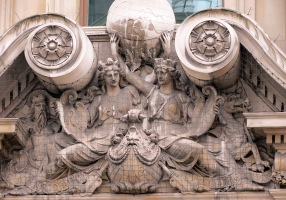 Liverpool, London and Globe Insurance, no. 1 Cornhill .
Liverpool, London and Globe Insurance, no. 1 Cornhill .
The next building along the south side of Cornhill, very thin, only three bays wide, is no. 14 Cornhill. This bears superior sculptural work in the form of two crouched nude figures, male and female, above one window, with between them a cartouche with a tiny figure of St Andrew, presumably a reference to the parish of St Andrew Cornhill. The figures are nicely if heavily modelled, and in pose are rather reminiscent of the work of Schenck.
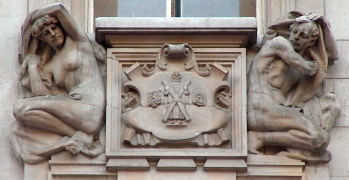 Crouched figures on No. 14 Cornhill.
Crouched figures on No. 14 Cornhill.
In the centre of the road here is a statue of James Henry Greathead, chief engineer of the City and South London Railway, a modern work by the sculptor James Butler, installed in 1994. A good pose to the figure with a bold hat to give a fine silhouette from a distance.
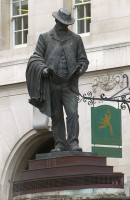 Greathead, engineer, by James Butler.
Greathead, engineer, by James Butler.
Next along, above Pope s Head Alley, is nos. 15-22, on an epic scale with giant Corinthian attached pillars above arches, like some Whitehall Government office, but built as the London headquarters of Lloyds bank at the end of the 1920s to the designs of Sir John Burnet (architect of the Edward VII Galleries at the British Museum), Campbell-Jones and Smithers; apparently the interiors survive intact. Above the entrance, three bays along, is a shield bearing a low relief of the Lloyds horse.
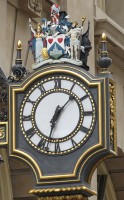
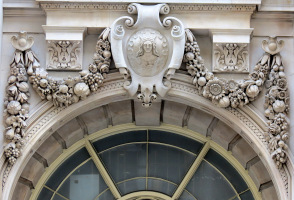 Details from side of Royal Exchange to Cornhill.
Details from side of Royal Exchange to Cornhill.
On the opposite, north side of Cornhill, we have the exterior flanking wall of the Royal Exchange, with giant pilasters between two-storey arches enclosing windows and lunettes, and above the latter, and beneath the higher storey, spandrels containing lots of carved fruits.
The rear of the building faces onto an open pedestrian cut-through, separating it from the Royal Exchange Buildings. The Royal Exchange dates from the early 1840s (architect William Tite), the third building of that function on the site, and it is this reverse side which bears a tower incorporating a statue of the founder of the Royal Exchange, Sir Thomas Gresham. This dates from the completion of the building in 1845, and is by the sculptor William Behnes.
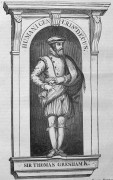 Previous statue of Gresham on the Royal Exchange.
Previous statue of Gresham on the Royal Exchange.
There are two fountains in the pedestrianised way, and that at the Cornhill end in red and black granite once contained under the canopy a statue by Joseph Whitehead, dated 1911. This was lost to vandalism at the end of the 1980s, and replaced by a new bronze semidraped girl by Stephen Robert Melton entitled Serenity , who though lacking in the nobility of the face, had a graceful stance pouring from her jug. However, this figure has now also disappeared. Although not part of our walk down Cornhill, we should mention that the other fountain, at the Threadneedle Street end, in red and black-and-white granite, put up with financial aid from the Drapers and Merchant Taylors Companies in 1878, bears a bronze Motherhood group by Dalou, dated 1879. And we must also mention that at that end of the pedestrianised route is a statue of the American philanthropist and builder of the eponymous housing for the poor, Peabody, by William Wetmore Story, an important early American sculptor, dated 1868.
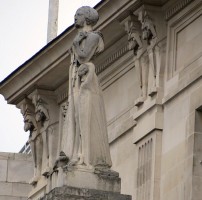
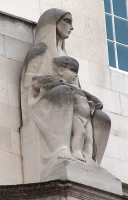
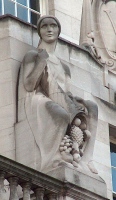 1930s sculpture high up on south side of Cornhill.
1930s sculpture high up on south side of Cornhill.
Back on the south side is Number 24, much narrower at 5 bays than the Lloyds HQ building, but with a similarly high elevation and the same age, has four pots above first floor as part of a rather restrained classicism; it is by the architect Maurice Webb. High up on the pediment, impossible to view properly except at a distance along the road, is a freestanding stone figure of a girl wearing deco robes, rather worn due to the exposed position. And next along from that, the building now occupied by Pitcher Piano has two seated female figures high up, one with a cornucopia, the other with a small boy, so probably a Virgin and child as a nod to the nearby churches. Sensitive work of the deco period.
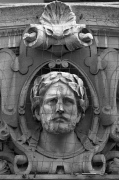
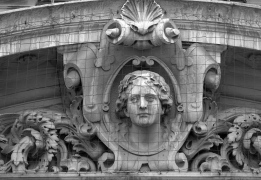 Details from nos. 33-35 Cornhill.
Details from nos. 33-35 Cornhill.
Cornhill Insurance Co at no.32 is disappointingly plain, but the next building nos. 33-35, which takes us to the corner with Birchin Lane, is a satisfyingly ornate Italian palazzo of the 1850s. Six bays wide, it has twin entrances at the outer edges, with floral filling of the spandrel positions (with the date 1858 among the leaves) above the arched porticos, and above the entablature, round-headed pediments each bearing a classical head with further swirls and wreaths and birds. These heads consist of a Roman emperor type with beard and laurel wreath, and a woman with ringletted hair.
At this point, Birchin Lane branches off to the south, and Finch Lane to the north it is worth taking a few steps along the latter, as just behind the Union Building on the corner is a flat, Queen-Annish style building with ornamented string course, curved pediments, and uprights between the bays treated rather splendidly as steles, bearing leafy bearded heads, almost like the pagan Green Man found on some churches. The main curved pediment has a shell design and a snarling lion's head.
St Michael Cornhill portico, Goulden's War Memorial, Birnie Philip's tympanum, and Mercer's Maiden.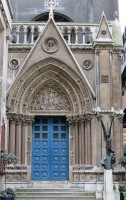
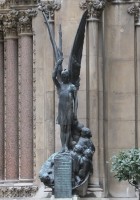
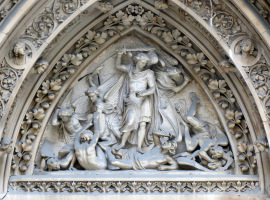
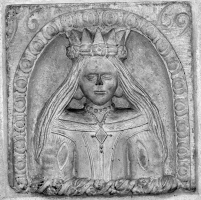
Back in Cornhill, a few paces further on, St Michael Cornhill is set back on the right hand side of the street. This is a Wren church, dating from 1670-2, bar the tower, but the bit we see from the street, which is the North Porch, is mid-19th Century work by George Gilbert Scott and W. A. Mason. The entrance has two significant main sculptures. To the right of the door as we look at it, is a small bronze WW1 Memorial, with a standing figure of a male angel with a sword, and below, a cluster of cherubic infants seeking refuge from some snarling big cat. A very vertical composition, this is a work by the interesting early 20th Century sculptor Richard Reginald Goulden.
Above the ornate door of the church is the other significant piece of sculpture a Gothic arch filled with a scene of St Michael not very energetically casting down Satan the subsidiary figures are far more lively. The composition as a whole is good obviously of vaguely triangular shape to fit the space, but with figures packed in, rather three-dimensionally, to give a medieval style sense of crampedness, rather in the manner of early English alabaster panels or Continental ivories. Around are a variety of leafy borders and little outstretched heads in roundels. The sculptor was the estimable J. Birnie Philip.
Alongside and behind the church is an explorable passage; on one wall is a small panel sculpted in high relief called the Mercers Maiden, bearing the date 1669, a symmetrical, rather stark representation of a crowned queen with long flowing hair and jewellery.
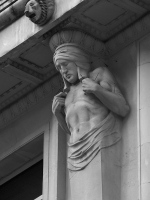
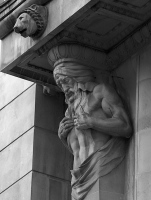 Two of the Atlantes from no. 73 Cornhill.
Two of the Atlantes from no. 73 Cornhill.
A few more steps along Cornhill on the other side is no. 73, the former Australia and New Zealand Banking Group building, by the architect G. Cuthbert, dating from 1896. Among a variety of decoration, this building has at the top half a dozen over-sized Atlantes figures, heavily muscular, with a variety of beards and turbans (see this page for more Atlantes and Caryatids). The exotic nature of these decorations is accentuated by the little Abyssinian lion heads along the parapet supported above.
Details on nos. 66-67 Cornhill, architect T Chatfield Clarke.
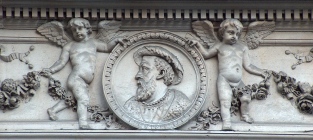
Two doors along, above Sun Court is no. 66-67, once Yorkshire House, an Italian Renaissance style work of 1880 by the architect T. Chatfield Clarke, who rather favoured light sculptural decoration on his buildings, has above the ground and first floors long, thin panels of pale terra cotta with paired cherubs. The higher level has the cherubs holding shields in wreaths, with ribbons and hanging floralities to the sides; the lower panels have central roundels with relief portrait heads, and larger festoons of flowers. These heads four in all are two bewhiskered Renaissance gentlemen with floppy hats, one of whom would seem to be Thomas Gresham, already met, and two females one classical, the other with some Dutch style head covering and a wide-splayed collar. At number 65, the Cornhill Magazine was produced from 1860.
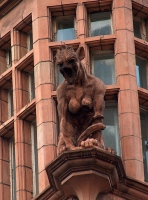
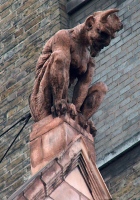
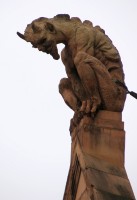 W. J. Neatby's gargoyles (two views of gable one) on 55-56 Cornhill.
W. J. Neatby's gargoyles (two views of gable one) on 55-56 Cornhill.
Nos. 54-55 on the opposite side are an oddity - in a street of mostly pale Classical buildings we find a red terra cotta construction which tends towards the Tudor, embellished with odd little details, and nothing odder than the two Gothic gargoyle beasts, one part way up on the corner, one at the summit of the main gable. They are masterful of their type; that on the gable is a crouching demonic figure, with evil satiric grimace, horns one broken, hulking forward to stare down at the passers-by on the street; the second is an ancient harpy, gaping mouth and empty eyes, hanging breasts more like udders, whiplash tail wound round one arm; a most disturbing spectacle. W. J. Neatby was the sculptor; we are used to much sweeter, more elegant and beautiful things from his hand, but there are other examples of his work which tends to the grotesque, and in particular some atlantes figures from Birmingham City Arcade (shown on this page) recall to us the gable figure at least. We should mention that the architect of this building was Ernest Runtz, better known for the Gaeity Theatre on the Strand, of which part of the fa ade and the important sculpture survives (see pictures on this page).
Next to this building, in complete contrast, is a Classical portico with coupled pillars and flat pilasters, which is the ever-closed entrance to the second surviving church on the street, St Peter upon Cornhill. This Wren church of 1681 was permanently closed to the public, but now opened again once a week for viewing. We can see the exterior, from round the corner in Gracechurch Street, also the tower from there, or round the back in the surviving little churchyard. See this page for the monuments in St Peter Cornhill.
And that brings us to the end of Cornhill - to the south runs Gracechurch Street, northwards Bishopsgate, and the eastern continuation of Cornhill becomes Leadenhall Street.
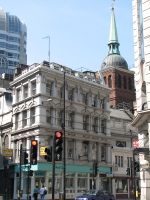 St Peter Cornhill from corner of Gracechurch Street.
St Peter Cornhill from corner of Gracechurch Street.
St Michael Cornhill monuments // North from East end along Bishopsgate to St Helen Bishopsgate // South of west end to St Mary Woolnoth // or St Stephen Walbrook
Visits to this page from 13 Mar 2014: 17,836